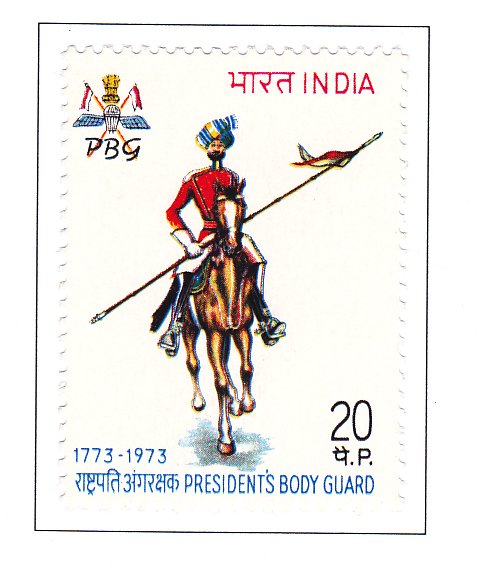President’s Body Guard 1773-1973

Technical Data
| Date of Issue | September 30, 1973 |
|---|---|
| Denomination | 20 nP |
| Quantity | 3,000,000 |
| Perforation | comb 13 |
| Printer | Security Printing Press, Nashik |
| Watermark | No Watermark |
| Colors | Multicolor |
| Catalog Codes |
Michel IN 577 Stamp Number IN 593 Yvert et Tellier IN 379 Stanley Gibbons IN 697 |
| Themes | Animals (Fauna) | Anniversaries and Jubilees | Equestrianism and horse riding | Horses | Mammals | Military Forces |
The President’s Body Guard, commemorating its bicentenary on September 30, 1973, holds a unique status within the Indian Army, superseding all other units. Established in 1773 by Warren Hastings in Banaras, it initially served both operational and ceremonial purposes. Over the next eighty years, it participated in major campaigns, with the Governor-General leading as Commander-in-Chief.
Originally raised as a cavalry unit when the Bengal military lacked such forces, the Body Guard has remained mounted for two centuries. Despite its equestrian tradition, it has served in various capacities, including artillery (in Egypt, 1801-1802), marines (in 1809), dismounted cavalry (in Java, 1811), mechanized troops (in World War II, 1943), and paratroopers (as part of the 44 Airborne Division, 1944-46).
Initially known as ‘The Governor’s Troops of Moguls’ in 1773, it later became ‘The Governor-General’s Body Guard’ from 1784. Since 1950, it has been named ‘The President’s Body Guard’. While its strength has remained roughly constant—2 officers and 112 other ranks—it has expanded during wartime, reaching nearly two thousand members in 1845.
The ceremonial uniform includes a blue turban with gold embroidery, a scarlet frock coat with regimental brass buttons, white pantaloons, Napoleon boots with spurs, and a bay-colored horse with a blue saddle cloth and red-and-white pennant on the lance. The motto “Bharat Mata Ki Jai” signifies the guard’s dedication to the nation.
Recruits to the Body Guard are meticulously selected for their horsemanship, tank skills, and parachuting abilities. The minimum height requirement for enlistment is six feet. The Posts & Telegraphs Department proudly commemorates the unit’s 200th anniversary with a commemorative stamp, honoring its distinguished service and tradition.
